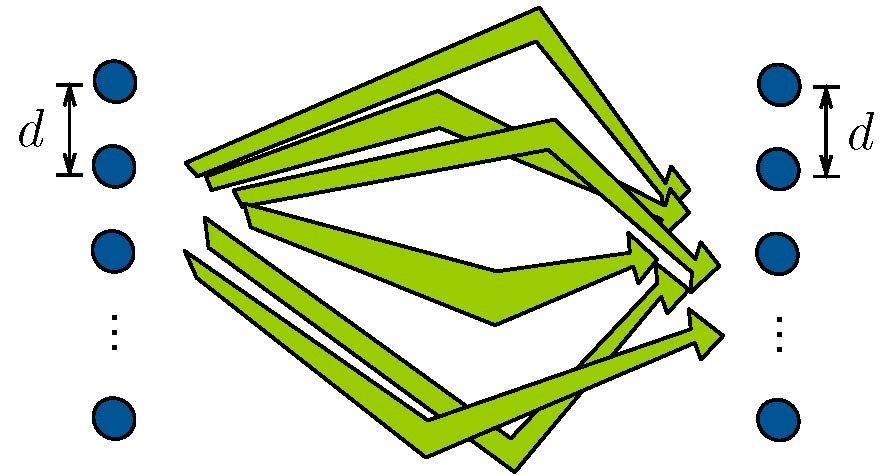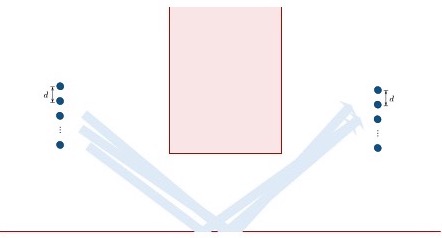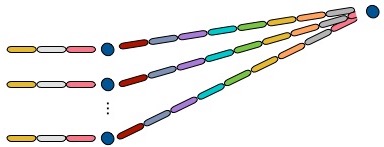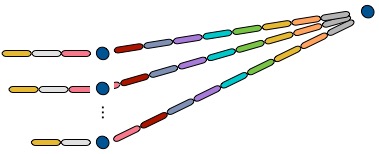Near-Field MIMO Communication
Near-Field MIMO Communication
Near-Field MIMO Communication
Advanced releases of 5G, and eventually 6G, will operate at frequencies beyond 100 GHz. In conjunction with an ever shorter range, this opens up a new realm for MIMO communication that does not require multipath propagation: near-field MIMO.
Multiple-input multiple-output (MIMO) communication is a core technology in 4G and 5G wireless networks, as well as WiFi. To date, this technology has been applied at frequencies below 6 GHz and in far-field conditions, relying on multipath propagation (see figure below). In this paradigm, the environment acts as a lens that enables the receiver to resolve the signals emitted by each individual transmit antenna with spacings d as small as half wavelength (4 cm at 3.5 GHz, such that a 12 x 12 cm array can multiplex 16 signals).

As we move to advanced releases of 5G, and eventually 6G, bands will open at frequencies above 100 GHz, and this is bound to be a game-changer. The boundary between the near field and the far field is determined by the so-called Fraunhofer distance,
![]()
where L is the longest dimension of the transmitting array and λ is the wavelength. At classical 4G/5G/WiFi frequencies of 2-5 GHz, this boundary is at less than 1 meter, hence operation always takes places in far-field conditions. However, as we move past 100 GHz this boundary is pushed out to tens of meters, or even further. Given the shrinking ranges over which radio access takes place, in many applications it will become possible to operate within that boundary. This, in turn, will enable a new form of MIMO (near-field MIMO) that does not require multipath propagation. Rather, the arrays themselves will provide a large-enough aperture to resolve the signals, even in the absence of multipath, such that MIMO can take place over a line-of-sight connection or via a single reflection. Referring to the toy setting in the figure below with an antenna spacing of d=5 cm: for D0 and D1 to differ by a quarter wavelength, such that the respective signals can be distinguished by the receiver, the receiver would have to be at a few cms from the transmitter. However, at 30 GHz, that extends to 10 m; up to that distance, a 15 x 15 cm array could spatially multiplex 16 signals. Increasing d pushes the range further out.

Hence, with similarly compact arrays, spatial multiplexing comparable to what is possible at sub-6 GHz frequencies can be achieved above 100 GHz -- even though multipath propagation is scarce or outright nonexistent at these frequencies. Precisely, the number of signals that can be spatially multiplexed, what is usually referred to as the number of signaling degrees-of-freedom (DOF), equals
![]()
where At and Ar and the transmit and receive array apertures while D is the range. Note the inverse relationship with the wavelength, whereby, for given arrays and range, the number of signals that can be multiplexed grows squarely with the frequency. Conjugating such high multiplexing orders with the enormous bandwidths available above 100 GHz, near-field MIMO offers the promise of bit rates approaching 1 Tb/s. However, to turn this promise into reality, a number of technical hurdles must be overcome. This project is tackling some of these key obstacles.
One of our research thrusts has been to prove that the properties of a near-field MIMO link are preserved when the signal experiences a clean reflection off a smooth surface, say a wall, floor, or ceiling.

This has been succesfully confirmed, in collaboration with New York Univerdity, with results published in:
- A. Pizzo, A. Lozano, S. Rangan, T. Marzetta, “Wide-Aperture MIMO via Reflection off a Smooth Surface,” IEEE Trans. Wireless Communications, Vol. 22, 2023.
- A. Pizzo, A. Lozano, S. Rangan, T. Marzetta, “Line-of-Sight MIMO via Reflection from a Smooth Surface,” IEEE Vehicular Techn. Conf. (VTC Spring), Helsinki, Finland, June 2022
Another line of work, again in close collaboration with New York University, has been to establish how the number of signaling DOF changes if, besides a line-of-sight component, the channel exhibits also a certain amount of multipath propagation and scattering. The resuls have been released in:
- A. Pizzo, A. Lozano, "On Landau's Eigenvalue Theorem for Line-of-Sight MIMO Channels," IEEE Wireless Communications Letters, Vol. 11, No. 12, Dec. 2022, pp. 2565-2569
Finally, a major focus has been on the so-called spatial wideband effect that arises when the bandwidth becomes truly large, say multiple GHz. At these bandwidths, symbols are so short (sub-nanosecond once the bandwidth exceeds 1 GHz) that they no longer align properly at the receiver, as this figure illustrates.

In non-MIMO transmissions such as this one, the problem can be fixed by applying correcting delays at the transmitter, a technique termed true-time-delay beamforming:

In MIMO, however, the missalignment is different at each receive antenna. Given Nt transmit and Nr receive antennas, there are NtNr signal paths to correct, but at most we can apply Nt + Nr delays including transmitter and receiver. In our research, we have identified certain properties of channels that suffer this problem and, capitalizing on them, we have come up with techniques to effect a very satisfactory correction of all signal paths with only these reduced number of controllable delays. This work has led to multiple papers:
- M. Mojahedian, A. Lozano, “Precoding and Reception for ULA-Based Wide-Aperture MIMO,” IEEE Wireless Communications Letters, Vol. 12, 2023.
- M. Mojahedian, M. Attarifar, A. Lozano, “DFT-Based Wideband Line-of-Sight MIMO Communication,” IEEE Global Commun. Conf. (GLOBECOM), Rio de Janeiro, Brazil, Dec. 2022
- M. Attarifar, M. Mojahedian, A. Lozano, "Reduced-Complexity Wideband Line-of-Sight MIMO Communication," Invited Paper at the Asilomar Conf. on Signals. Systems and Computers, Pacific Grove, USA, Nov. 2022
- M. Mojahedian, M. Attarifar, A. Lozano, “Spatial-Wideband Effect in Line-of-Sight MIMO Communication,” IEEE Int’l Conf. Communications (ICC), Seoul, Korea, May 2022
